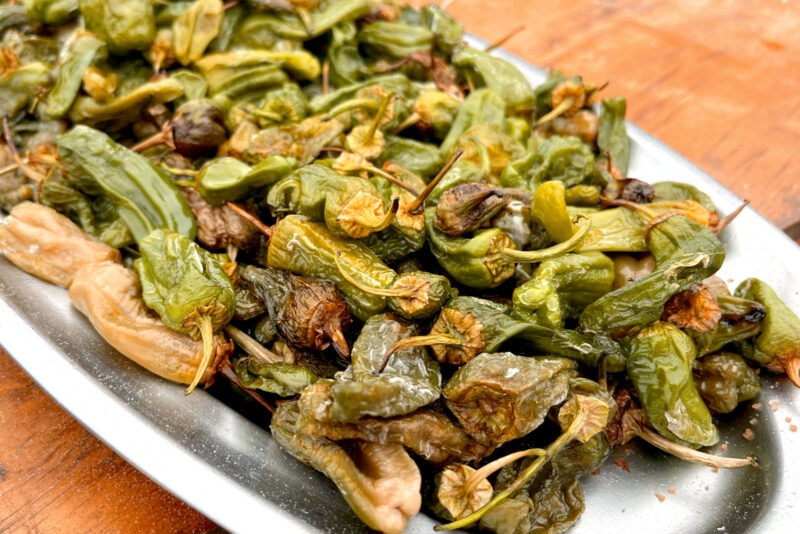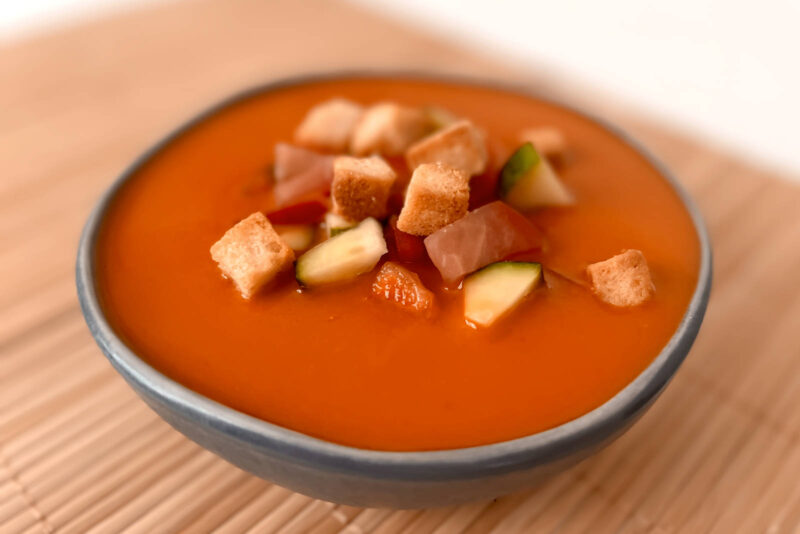10 Tastiest Spanish Vegan & Vegetarian Tapas to Try in Spain
Are you wondering what vegetarians eat in Spain? Given the country’s long-lasting love affair with pork and seafood dishes, this is a valid question. But the truth is that there are so many vegetarian tapas in Spain, that it’s unlikely you’ll feel like you’re missing out.
As Spain continues to be one of the countries with the highest consumption of meat per capita, the line between vegetarianism and veganism is still a bit blurry for most people.
Add to that that many Spaniards, especially the older generations, actually consider tuna and jamón (dry-cured ham) to be vegetables (don’t ask me why?, I’ll never understand), and you might not be that surprised to see tuna sandwiches labeled as vegetal.
So it’s understandable if you’re worried that eating in Spain as a vegetarian or vegan will be difficult.
But it doesn’t have to be if you know what to look for on restaurant menus or rent out a place with a kitchen to take full advantage of Spain’s veggie bounty.
The following vegetarian Spanish tapas are all meat and seafood free. And they have the added advantage that they are also pretty easy to prepare at home.
According to Unión Vegetariana Española, up to 13% of the population in Spain is at least flexitarian, which recently resulted in a rising number of vegetarian and vegan-friendly restaurants, especially in major Spanish cities.
This is amazing because in these places you don’t have to wonder if your veggies were deep fried in the same oil as meat or fish dishes were fried, which might be the case in your average tapas bar.
So without further ado, here are my favorite traditional vegetarian tapas. They are popular around the country and most Spanish bars have at least some of these veggie tapas on their menu.
Patatas bravas [vegetarian tapas]

Patatas bravas are the Spanish vegetarian tapas par excellence and you’ll see them on every tapas menu in Spain. When done right, patatas bravas are pure crispy, spicy, garlicky goodness, and the best thing that could happen to a potato.
Unfortunatelly, not all Spanish tapas bars have mastered the art of cooking patatas bravas, and oftentimes what you’ll get is a plate of soggy potatoes with bad ketchup and mayo instead of spicy brava sauce and fresh garlic alioli.
So my advice is to do your research before going out for vegetarian tapas in Spain. And if you want to make your patatas bravas vegan, order them without alioli.
Tortilla de patatas [vegetarian tapas]

Officially, Spain doesn’t have a specific national dish, but if it had, this honor would most likely fall to the humble tortilla de patatas. This popular vegetarian tapa is a beautiful mix of eggs, potatoes, olive oil, salt, and sometime slow-cooked caramelized onions (although this is a much-debated addition).
Tortilla de patatas is one of the most popular Spanish foods and is eaten pretty much any time of the day, be it hot or cold, by the slice, or in bocadillo sandwiches with mayo or grated tomatoes.
This golden potato omelet is gooey perfection and a source of national pride. It’s one of the tapas Spaniards miss the most when going abroad and one of the first foods they have upon returning home.
Pimientos de padrón [vegan tapas]

When it comes to vegan Spanish tapas, it hardly gets any better than pimientos de Padrón. These beautiful bright green small peppers from the Padrón municipality in Galicia, are the opposite of boring – while most of them are mild, occasionally, you’ll bite into one that is really hot.
There’s no way of knowing beforehand, so eating these delicious veggie tapas is like playing Russian Roulette with your food. The hot ones are generally about half as hot as an average jalapeño pepper, while the rest are deliciously bittersweet.
Pimiento de Padron are traditionally prepared by quickly frying them in olive oil until they blister. They are served whole with big flakes of salt sprinkled on top. Some restaurants and bars would stir-fry them with jamón Iberico (dry-cured ham) for extra flavor, so read the menu carefully or ask your waiter.
Gazpacho [vegan tapas]

Traveling all the way south, you’ll find the jewel of Andalucian cuisine – the refreshing gazpacho. This vivid red cold soup is made with raw tomatoes, peppers, cucumbers, onions, garlic, olive oil, and vinegar, all blended to tasty perfection.
Gaspacho is one of the healthiest vegetable tapas, just perfect for a hot summer day. It can be siped directly from a glass or eaten from a bowl as any other soup. It is usually topped with croutons, diced tomatoes, cucumbers, and peppers, for an extra crunch and a splash of olive oil for added flavor.
Besides the original gazpacho recipe, some restaurants in Spain also serve creative versions of the famous veggie soup, such as watermelon, strawberries, or beets gazpacho and they are just as glorious.
Berenjenas a la miel [vegan tapas]

Berenjenas a la miel is one of the most surprising vegan tapas in Spain. It’s a dish that hails from Cordoba and is one of the most delicious legacies of Moorish cuisine in the southern part of the country.
Berenjenas a la miel are basically thin eggplant sticks tossed into flour and deep-fried in olive oil until crisp perfection. These vegan Spanish tapas are then served with a drizzle of miel de caña – dark, sweet, sticky syrup made from sugar cane.
Contrary to their name, these simple veggie tapas are not made with honey. But they are sweet, deep-fried, and overall, some of the tastiest Spanish vegan tapas.
Spanish olives [vegan tapas]

Olives are among the simplest and most popular vegan tapas in Spain. Literally, every bar in the country serves them, and most of them will bring out a small olive plate on the house when you order a drink.
Olives are among the few Spanish tapas that are still keeping the tradition of serving a free tapa with each drink alive. They are usually served whole, as many Spaniards love to chew around the pit.
Exceptions are stuffed olives (they are usually stuffed with red peppers or anchovies, so pay attention) and olive skewers. Olive skewers can be amazing vegetarian or vegan tapas, especially when they are made with cheese, pickled peppers, or pickled onions. However, not all olive skewers are vegetarian-friendly, some being made with anchovies, mussels, or salmon.
Champiñones rellenos de ajo y perejil [vegan tapas]

Spain has a thing for both garlic and mushrooms, but when you pair the two, it’s guaranteed to be love at first bite. So naturally, you will find all kinds of mushrooms on tapas menus around Spain, but if you want to treat yourself, order some champiñones rellenos de ajo y perejil (garlic and parsley stuffed mushrooms).
As the garlic sizzles inside the mushrooms while being cooked, it infuses them with a bold, garlicky flavor, which in combination with the firm, meaty texture of the mushrooms, results in one of the best vegan tapas you’ll ever taste. Plus it’s super healthy according to these garlic facts.
These Spanish vegan tapas pair to perfection with a glass of Rioja red wine, but you can also accompany them with other typical Spanish drinks.
Pan con tomate [vegan tapas]

Pan con tomate, pa amb tomàquet, or pan tumaca, depending on where you are in Spain, is one of the most unexpectedly delicious Spanish vegan tapas.
This super easy-to-make bread toast with grated tomatoes, extra virgin olive oil, and salt is a classic Spanish breakfast recipe. But it is so good, that Spaniards will snack on it any time of the day, especially as an appetizer before dinner. Once you’ve sunk your teeth in all its crusty, savory deliciousness you’ll immediately understand why.
Preparing pan con tomate at home is super easy, but grating tomatoes for dozens of daily hungry patrons is not so much fun. So many restaurants and bars use canned grated tomatoes. While good, when you find a place that serves homemade freshly grated tomatoes, you’ve found a gem.
Croquetas [vegetarian tapas]

Croquetas are the best bar food ever invented. Deep-fried and wonderfully creamy, you will find them pretty much anywhere you go in Spain.
Croquetas can be made with any number of things, from ham and seafood to veggies. Some of the most popular vegetarian croquetas are made with spinach (croquetas de espinacas), wild mushrooms (croquetas de setas), or blue cheese (croquetas de queso azul).
What makes croquetas so great is that they are crispy and packed with flavor. The filling is typically made from a thick béchamel sauce to which the other ingredients are added.
Revuelto [vegetarian tapas]
While in many countries around the world people have scrambled eggs for breakfast, Spaniards don’t subscribe to this trend. Instead, they prefer to eat scrambled eggs in the afternoon or evening, as filling vegetarian tapas.
Revueltos are typically served with one or two other ingredients mixed in. Some of the most popular plant-based add-ins are setas (mushrooms), espárragos (asparagus), and ajos tiernos (green garlic), but the possibilities are endless!
Rich and delicious, revueltos are dairy-free and pack a universe of flavor. Like every other vegetarian tapas on this list, revueltos are also cooked with olive oil, and the soft egg curds don’t overwhelm the other ingredients.






